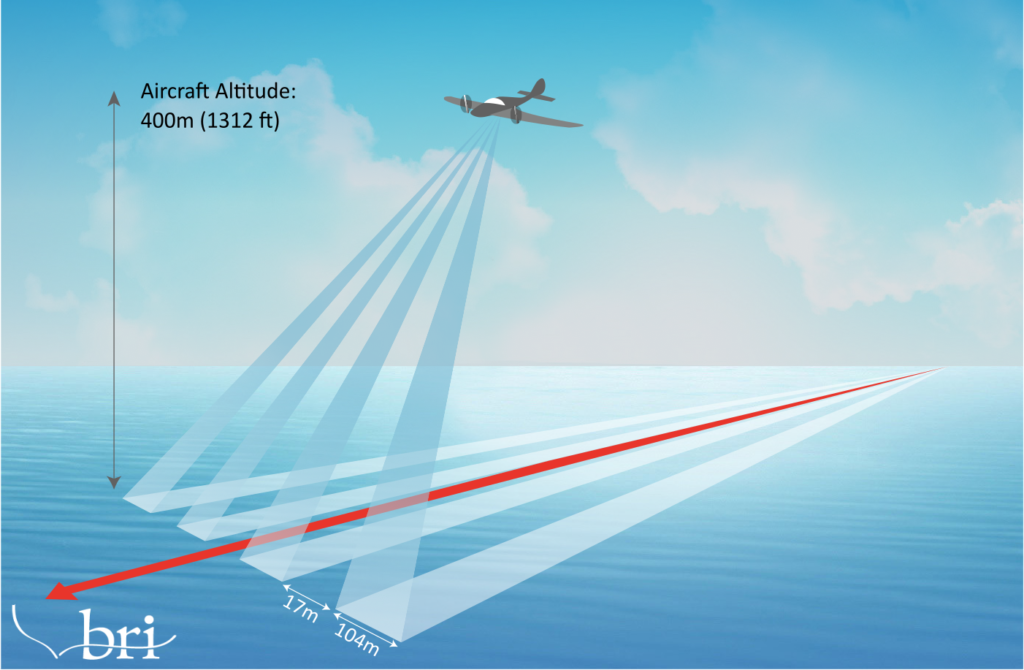Digital aerial surveys for wildlife in the Gulf of Maine
BRI, in collaboration with HiDef Aerial Surveying, is conducting digital video aerial surveys to obtain ecological baseline data and to inform siting of offshore wind development in the Gulf of Maine. Funded by the Bureau of Ocean Energy Management (BOEM), surveys will be conducted in 2023–2024 to better understand the distributions of marine wildlife across the Gulf of Maine.
BRI/ HiDef Staff
BRI lead investigators – Dr. Iain Stenhouse, Kate Williams, Dr. Evan Adams
BRI contributing staff – Andrew Gilbert, Dr. Julia Stepanuk, Edward Jenkins
HiDef investigators – Martin Scott, Kelly MacLeod
Project Goals

The goals of this project are to establish an ecological baseline describing the distribution and abundance of birds, marine mammals, and sea turtles in the Gulf of Maine. Offshore seasonal wildlife surveys will be carried out to obtain spatially explicit density and abundance estimates.
Pictured left is an example image from digital aerial surveys of a surfacing minke whale (Balaenoptera acutorostrata).
Project Background
Digital aerial surveys collect data on a variety of wildlife (including birds, marine mammals, sea turtles, and fish), as well as anthropogenic activities (for example, vessels and marine debris). Visual aerial surveys require manned observations and detections, while digital aerial surveys use still or video camera systems to obtain high resolution imagery of the sea surface. Because digital aerial surveys do not rely on visual observations, they can be flown at faster speeds and higher altitudes than traditional visual aerial surveys, making them safer for human operators while causing less disturbance to the animals that are surveyed. HiDef’s digital video system can obtain 6–8 images of each object, which assists with determining species identification, behavior, and animal size. In addition to recording the locations of all wildlife sightings, HiDef is able to calculate the flight heights of birds from the survey data using size-based estimation, where the sizes of birds at known altitudes are used to help estimate the altitude of other individuals of the same species.

Project Activities
 Surveys will begin in the spring of 2023 and occur once per season for at least one year. All data from the project will be made publicly available alongside a BOEM final report, expected in late 2024.
Surveys will begin in the spring of 2023 and occur once per season for at least one year. All data from the project will be made publicly available alongside a BOEM final report, expected in late 2024.
Objects will be flagged in images by trained, experienced HiDef reviewers, and a subset are re-reviewed to confirm the accuracy of object detection. Images with flagged objects are then passed to experienced marine biologists trained in the analysis of high-resolution video imagery of birds, marine mammals, and other wildlife, to identify species or species groupings. Similarly, a subset of identified images will be re-reviewed by biologists to inform the identification accuracy. In addition, all images identified as being terns, Pterodroma petrels, and species listed as threated or endangered by the federal government or state of Maine will be re-reviewed, providing greater certainty in the identification of these key taxa of interest. Next, flight height calculations will be conducted for identified birds using size-based estimation (Humphries et al., 2023).
Lastly, all vessels, buoys, marine debris, and other human activity at sea is recorded with as much relevant information as possible
Study Design
Surveys will operate seasonally in the Gulf of Maine according to the survey design below . Transects (in black) are spaced 5 km apart and cover 8.4% of the study area. By flying at an altitude of 400 m, HiDef will obtain imagery at a ground spatial resolution of 1.5 cm.

To refine the geographic scope and design of these BOEM-funded surveys, the project team conducted three stakeholder meetings in September–October 2022 to obtain input on focal locations, species, and other factors to consider when developing the survey boundary. In response to feedback, BRI and HiDef proposed the study boundary (above) to distribute survey effort across ecological gradients and areas of ecological interest that stakeholders identified as priorities for baseline data collection.
Project Funding
Study concept, oversight, and funding were provided by the U.S. Department of the Interior, Bureau of Ocean Energy Management, Division of Environmental Sciences, Washington DC, under Contract Number M17PC00012.
Photo Credits: Header photo © Shutterstock; Minke Whale © HiDef; Aerial Survey Illustration © BRI- Iain Stenhouse; Airplane © M. Harkin; Draft Call Area © BRI- Julia Stepanuk


